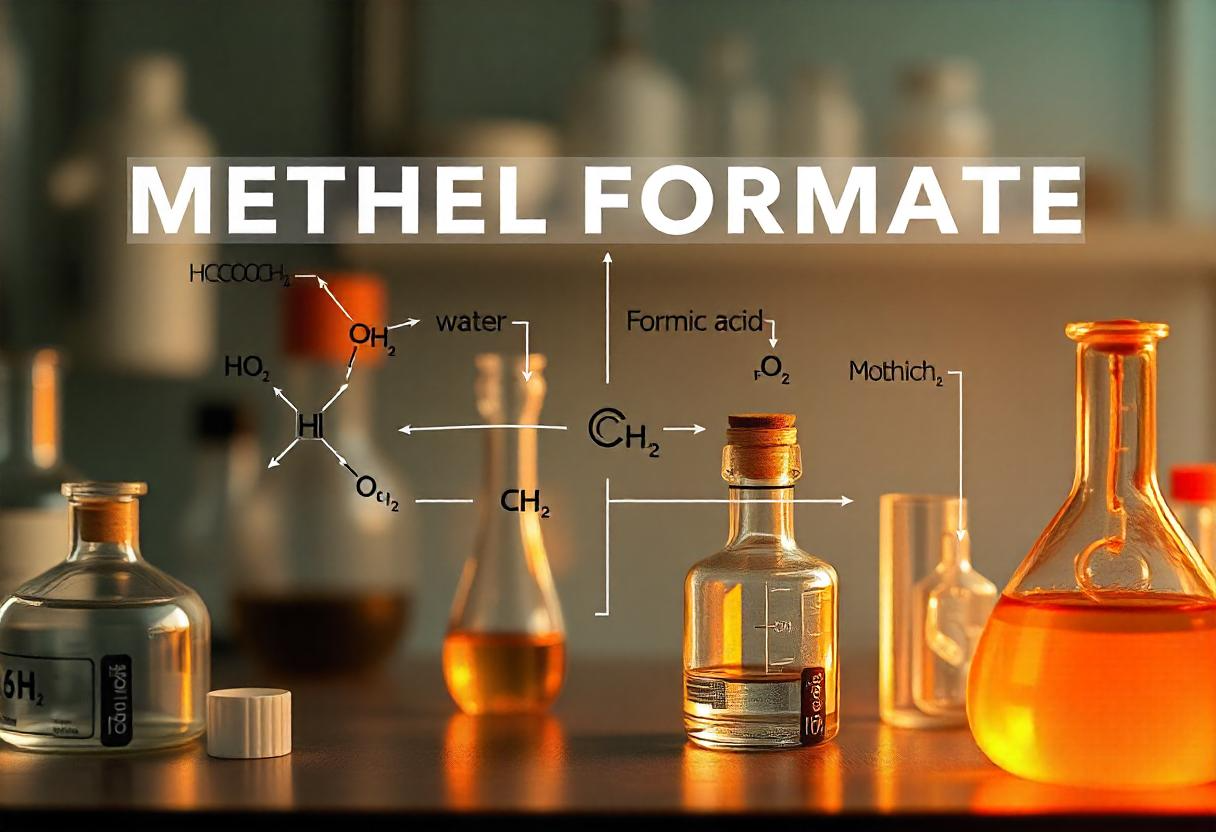The chemical reaction HCOOCH CH2 H2O represents the hydrolysis of methyl formate, an ester commonly used in industrial processes. This reaction is significant in organic chemistry, leading to the formation of formic acid (HCOOH) and methanol (CH3OH). Both of these compounds have widespread applications in industries such as pharmaceuticals, agriculture, and chemical manufacturing.
Understanding the hydrolysis of methyl formate provides insights into ester cleavage mechanisms, reaction conditions, and industrial significance. In this article, we explore the chemical properties of methyl formate, the factors influencing its hydrolysis, and its practical applications.
Chemical Reaction of HCOOCH CH2 H2O
The hydrolysis of methyl formate follows the general ester hydrolysis mechanism, where the ester reacts with water to produce an alcohol and a carboxylic acid. The balanced equation is:
HCOOCH3+H2O→HCOOH+CH3OHHCOOCH_3 + H_2O → HCOOH + CH_3OH
Mechanism of Hydrolysis
The reaction occurs in two main steps:
- Nucleophilic Attack: A water molecule donates electrons to the carbonyl carbon of methyl formate, forming a tetrahedral intermediate.
- Bond Cleavage: The intermediate breaks down, leading to the formation of formic acid and methanol.
Depending on the conditions, the reaction can proceed via acid-catalyzed or base-catalyzed hydrolysis.
- Acid-Catalyzed Hydrolysis: The ester undergoes protonation, increasing its susceptibility to nucleophilic attack by water.
- Base-Catalyzed Hydrolysis (Saponification): A hydroxide ion (OH⁻) attacks the ester, leading to an irreversible formation of a carboxylate ion and alcohol.
Factors Affecting the Hydrolysis of Methyl Formate
Several factors influence the rate and efficiency of this reaction:
1. pH Conditions
- Acidic conditions speed up the reaction by protonating the ester.
- Basic conditions result in a faster and irreversible reaction due to the strong nucleophilic attack by hydroxide ions.
2. Temperature
- Higher temperatures increase reaction rates due to enhanced molecular collisions.
- Excessive heat, however, may cause side reactions or decomposition.
3. Catalyst Presence
- Strong acids (HCl, H₂SO₄) accelerate ester cleavage.
- Strong bases (NaOH, KOH) lead to saponification, forming a salt of formic acid.
4. Water Availability
- A higher concentration of water shifts the equilibrium towards hydrolysis, favoring the production of formic acid and methanol.
5. Solvent Effects
- Polar solvents like water enhance hydrolysis, while non-polar solvents may slow down the reaction.
Industrial Applications of Methyl Formate Hydrolysis
The hydrolysis of methyl formate plays a crucial role in industrial chemistry, yielding two valuable products:
1. Production of Formic Acid (HCOOH)
Formic acid is used in:
- Textile Industry: As a dyeing agent.
- Agriculture: As a preservative in animal feed.
- Leather Tanning: To enhance the quality of leather.
- Chemical Industry: As a reducing agent in chemical syntheses.
2. Synthesis of Methanol (CH3OH)
Methanol is widely used in:
- Fuel Production: As an alternative energy source.
- Solvent Manufacturing: In paint, plastics, and pharmaceuticals.
- Chemical Feedstock: For formaldehyde and acetic acid production.
3. Application in Pharmaceutical Industry
- Formic acid derivatives are utilized in the synthesis of antibacterial and anti-inflammatory drugs.
- Methanol is used as a solvent for pharmaceutical formulations.
Environmental Impact of Methyl Formate Hydrolysis
The industrial use of methyl formate and its hydrolysis process has environmental implications.
1. Carbon Footprint
- The production and use of methanol contribute to greenhouse gas emissions.
- Sustainable alternatives like bio-based methanol are being explored.
2. Water Contamination
- Uncontrolled discharge of formic acid may lower the pH of aquatic ecosystems, affecting marine life.
- Proper waste treatment protocols must be implemented to neutralize acid residues.
3. Safety Concerns
- Methyl formate is highly flammable, posing a fire hazard in storage and transportation.
- Formic acid is corrosive, requiring proper handling and disposal methods.
Comparison of Ester Hydrolysis Reactions
| Ester | Products of Hydrolysis | Industrial Use | Reaction Type |
|---|---|---|---|
| Methyl Formate (HCOOCH₃) | Formic Acid + Methanol | Solvent, fuel, pharmaceuticals | Acid/Base Hydrolysis |
| Ethyl Acetate (CH₃COOCH₂CH₃) | Acetic Acid + Ethanol | Food flavoring, adhesives | Acid/Base Hydrolysis |
| Methyl Benzoate (C₆H₅COOCH₃) | Benzoic Acid + Methanol | Preservative, fragrance | Acid Hydrolysis |
Safety Precautions When Handling Methyl Formate
To ensure safe handling and usage of methyl formate and its hydrolysis products, follow these safety measures:
1. Personal Protective Equipment (PPE)
- Wear gloves, goggles, and lab coats when handling chemicals.
- Use respirators in areas with high vapor concentrations.
2. Proper Storage Conditions
- Store in well-ventilated areas away from heat sources.
- Keep containers tightly sealed to prevent vapor leaks.
3. Handling and Disposal
- Neutralize formic acid residues before disposal.
- Store methanol safely, as it is highly toxic when ingested.
4. Fire and Chemical Spill Response
- Use CO₂ or dry chemical extinguishers for methyl formate fires.
- Contain spills using absorbent materials like sand or activated carbon.
Also read: WWE SmackDown Episode 1488: A Night of Unforgettable Action
Conclusion
The hydrolysis of methyl formate (HCOOCH CH2 H2O) is a vital reaction in organic and industrial chemistry. It leads to the formation of formic acid and methanol, both of which have wide-ranging applications in pharmaceuticals, fuel production, and chemical manufacturing.
Understanding reaction conditions, catalyst effects, and environmental impact is crucial for optimizing this process while minimizing potential hazards. As industries seek greener alternatives, advancements in sustainable methanol and eco-friendly ester hydrolysis methods continue to evolve.
FAQs
What is HCOOCH CH2 H2O?
It represents the hydrolysis reaction of methyl formate, which produces formic acid and methanol.
What is the purpose of methyl formate hydrolysis?
The process is primarily used for producing formic acid and methanol, which have applications in fuel, textiles, and pharmaceuticals.
Is methyl formate hydrolysis reversible?
In acidic conditions, the reaction is reversible, but in basic conditions, it leads to an irreversible saponification process.
What are the industrial uses of formic acid?
Formic acid is used in leather tanning, textiles, agriculture, and chemical synthesis.
Why is methanol important in industrial chemistry?
Methanol is a solvent, fuel additive, and feedstock for synthesizing other chemicals like formaldehyde.



